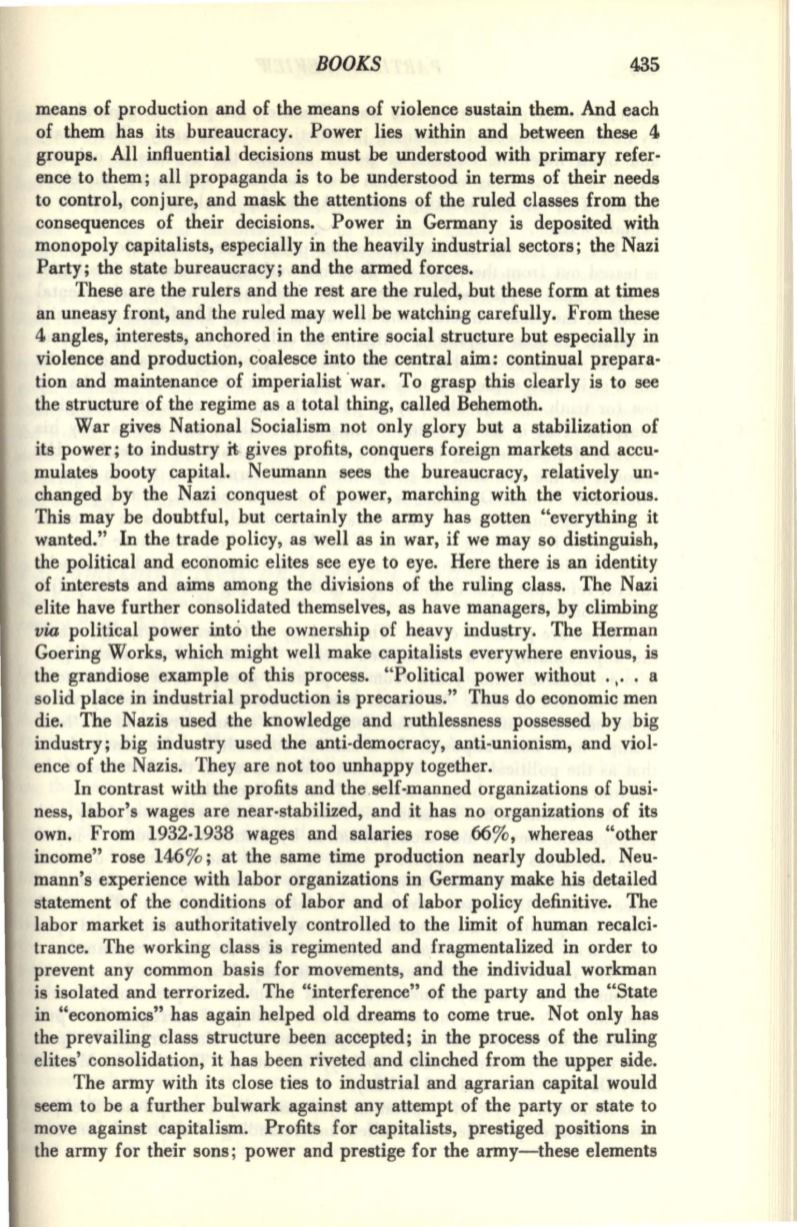
BOOKS
435
means of production and of the means of violence sustain them. And each
of them has its bureaucracy. Power lies within and between these 4
groups. All influential decisions must
be
understood with primary refer·
ence to them; all propaganda is to be understood in terms of their needs
to control, conjure, and mask the attentions of the ruled classes from the
consequences of their decisions. Power in Germany is deposited with
monopoly capitalists, especially in the heavily industrial sectors; the Nazi
Party; the state bureaucracy; and the armed forces.
These are the rulers and the rest are the ruled, but these form at times
an uneasy front, and the ruled may well be watching carefully. From these
4 angles, interests, anchored in the entire social structure but especially in
violence and production, coalesce into the central aim: continual prepara·
tion and maintenance of imperialist ·war. To grasp this clearly is to see
the structure of the regime as a total thing, called Behemoth.
War gives National Socialism not only glory but a stabilization of
its power; to industry
it-
gives profits, conquers foreign markets and accu·
mulates booty capital. Neumann sees the bureaucracy, relatively un·
changed by the Nazi conquest of power, marching with the victorious.
This may be doubtful, but certainly the army has gotten "everything it
wanted." In the trade policy, as well as in war, if we may so distinguish,
the political and economic elites see eye to eye. Here there is an identity
of interests and aims among the divisions of the ruling class. The Nazi
elite have further consolidated themselves, as have managers, by climbing
via
political power into the ownership of heavy industry. The Herman
Goering Works, which might well make capitalists everywhere envious, is
the grandiose example of this process. "Political power without . ,.. a
solid place in industrial production is precarious." Thus do economic men
die. The Nazis used the knowledge and ruthlessness possessed by big
industry; big industry used the anti-democracy, anti-unionism, and viol·
ence of the Nazis. They are not too unhappy together.
In contrast with the profits and the .self-manned organizations of busi·
ness, labor's wages are near-stabilized, and it has no organizations of its
own. From 1932-1938 wages and salaries rose 66%, whereas "other
income" rose 146% ; at the same time production nearly doubled. Neu·
mann's experience with labor organizations in Germany make his detailed
statement of the conditions of labor and of labor policy definitive. The
labor market is authoritatively controlled to the limit of human recalci·
trance. The working class is regimented and fragmentalized in order to
prevent any common basis for movements, and the individual workman
is isolated and terrorized. The "interference" of the party and the "State
in "economics" has again helped old dreams to come true. Not only has
the prevailing class structure been accepted; in the process of the ruling
elites' consolidation, it has been riveted and clinched from the upper side.
The army with its close ties to industrial and agrarian capital would
seem to be a further bulwark against any attempt of the party or state to
move against capitalism. Profits for capitalists, prestiged positions in
the army for their sons; power and prestige for the army-these elements


